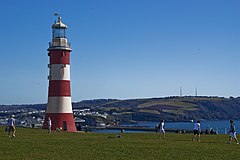Smeaton's Lighthouse
| Smeaton's Tower | |
|---|---|
 |
|
| General information | |
| Type | former lighthouse and memorial |
| Location | Plymouth, Devon, South West England |
| Coordinates | 50°21′52″N 4°08′31″W / 50.36441°N 4.14183°WCoordinates: 50°21′52″N 4°08′31″W / 50.36441°N 4.14183°W |
| Completed | 1759 |
Smeaton's Tower is a memorial to celebrated civil engineer John Smeaton, designer of the third and most notable Eddystone Lighthouse. A major step forward in lighthouse design, Smeaton's structure was in use from 1759 to 1877, until erosion of the ledge it was built upon forced new construction. The tower was largely dismantled and rebuilt on Plymouth Hoe in Plymouth, Devon, where it stands today.
The Royal Society recommended Smeaton for the task, and he modelled the lighthouse on an oak tree. He rediscovered the use of hydraulic lime, a form of concrete used in Roman times. The technique allowed concrete to set under water, as Smeaton put granite blocks together using dovetail joints and marble dowels. Construction started in 1756 at a site in Millbay, where Smeaton built a jetty and a workyard in the south-western corner of the harbour to unload and work on stones. Timber rails of 3 ft 6 in (107 cm) gauge were laid for four-wheeled flat trucks, which were used to move masonry around the site. A 10-ton ship named Eddystone Boat was based here, and transported worked stones out to the reef. The ship carried the 2¼-ton foundation stone out in the morning of 12 June 1756.
The work was completed in August 1759 at a cost of £40,000 (£5,623,178 with inflation). Many Cornish tin miners were employed in its construction. To avoid the possibility of press ganging, a practice which was common at the time, Trinity House arranged with the Admiralty that the workers would be immune from the press. Each worker was issued a medal to confirm he was a worker at the lighthouse.
The lighthouse was 72 feet high, and had a diameter at the base of 26 feet (8 metres) and at the top of 17 feet (5 metres).
After the structure was completed, the lighthouse's 24 candles were lit on 16 October 1759. Each candle weighed between 2 pounds (0.9 kg) and 5 pounds (2.3 kg). A timepiece placed alongside the light was set to chime every half-hour, alerting the lighthouse keeper to the need to replace expired candles.
...
Wikipedia
